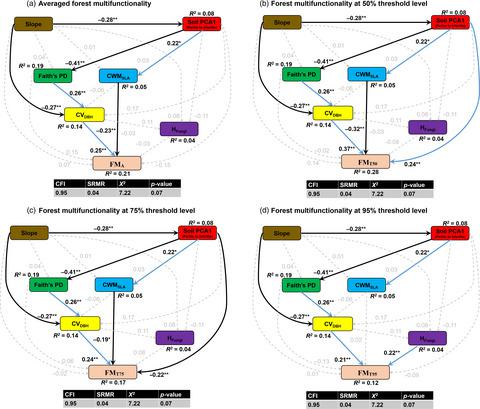Our official English website, www.x-mol.net, welcomes your feedback! (Note: you will need to create a separate account there.)
Above‐ and below‐ground biodiversity jointly regulate temperate forest multifunctionality along a local‐scale environmental gradient
Journal of Ecology ( IF 5.5 ) Pub Date : 2020-02-27 , DOI: 10.1111/1365-2745.13378 Zuoqiang Yuan 1 , Arshad Ali 2, 3 , Paloma Ruiz‐Benito 4, 5 , Tommaso Jucker 6 , Akira S. Mori 7 , Shaopeng Wang 8 , Xiaoke Zhang 1 , Hui Li 1 , Zhanqing Hao 1, 9 , Xugao Wang 1 , Michel Loreau 10
中文翻译:

地上和地下生物多样性共同沿着局部环境梯度调节温带森林的多功能性
更新日期:2020-02-27
Journal of Ecology ( IF 5.5 ) Pub Date : 2020-02-27 , DOI: 10.1111/1365-2745.13378 Zuoqiang Yuan 1 , Arshad Ali 2, 3 , Paloma Ruiz‐Benito 4, 5 , Tommaso Jucker 6 , Akira S. Mori 7 , Shaopeng Wang 8 , Xiaoke Zhang 1 , Hui Li 1 , Zhanqing Hao 1, 9 , Xugao Wang 1 , Michel Loreau 10
Affiliation

|
- Tree diversity has been shown to promote a broad range of ecosystem functions in forests. However, how important these effects are in driving ecosystem multifunctionality in natural forests, relative to other drivers, such as below‐ground biodiversity (e.g. soil microbial diversity), community‐level functional traits and environmental conditions, remains poorly understood. Here, we hypothesize that tree species or phylogenetic diversity (PD), stand structure, functional traits and soil microbial diversity jointly regulate temperate forest multifunctionality (FM) along a local‐scale environmental gradient.
- Using repeated census data from a 25‐ha old‐growth temperate forest, we first quantified eight ecosystem functions and properties related to above‐ and below‐ground nutrient cycling. We then used these to estimate ecosystem multifunctionality using both averaging and multiple threshold (50%, 75% and 95%) approaches. Finally, we used structural equation models to explore how different facets of tree (tree species, functional and PD) and soil (bacteria, fungi and nematode diversity) biodiversity influence ecosystem multifunctionality, as well as how these relationships are modulated by stand structural attributes and environmental conditions (topography and soil nutrients).
- Forest multifunctionality was positively related to stand structural complexity but negatively related to acquisitive traits (i.e. community‐weighted mean of specific leaf area). Plant PD had no significant direct effect on FM, but it had a significant indirect effect via increased stand structural complexity. The effect of soil microbial diversity on FM increased with increasing threshold levels of FM and outperformed tree diversity and environmental conditions at the highest threshold level (i.e. 95%). Forests on steep slopes had lower levels of ecosystem multifunctionality due to decreased stand structural complexity. Soil nutrients were responsible for regulating FM via plant trait composition and, to a lesser extent, via tree diversity, stand structure and soil microbial diversity.
- Synthesis. Plant PD, stand structure and soil microbial diversity jointly regulated FM, and these effects were influenced by local‐scale changes in environmental conditions. Soil microbial diversity was a key driver of highly multifunctional forests, whereas conservation of complex stand structure and conservative trait dominance could enhance mean values of multiple functions.
中文翻译:

地上和地下生物多样性共同沿着局部环境梯度调节温带森林的多功能性
- 树木的多样性已被证明可以促进森林中广泛的生态系统功能。但是,相对于地下生物多样性(例如土壤微生物多样性),社区一级的功能特征和环境条件等其他驱动因素而言,这些影响在推动天然林生态系统多功能性的重要性方面仍然知之甚少。在这里,我们假设树木物种或系统发育多样性(PD),林分结构,功能性状和土壤微生物多样性共同在局部环境梯度上调节温带森林的多功能性(FM)。
- 利用来自25公顷的旧温带森林的重复普查数据,我们首先量化了与地下和地下养分循环相关的八个生态系统功能和特性。然后,我们使用这些方法通过平均和多个阈值(50%,75%和95%)方法来估计生态系统的多功能性。最后,我们使用结构方程模型探索树木(树木的种类,功能和PD)和土壤(细菌,真菌和线虫多样性)的不同方面如何影响生态系统的多功能性,以及林分结构属性如何调节这些关系和环境条件(地形和土壤养分)。
- 森林的多功能性与林分结构复杂性呈正相关,而与获取性状(即特定叶面积的社区加权平均值)呈负相关。植物PD对FM没有明显的直接影响,但通过增加林分结构的复杂性却具有显着的间接影响。土壤微生物多样性对FM的影响随着FM阈值水平的增加以及在最高阈值水平(即95%)下表现出的树木多样性和环境条件的表现而增强。由于林分结构的复杂性降低,陡坡森林的生态系统多功能性水平较低。土壤养分负责通过植物性状组成调节FM,并在较小程度上通过树木多样性,林分结构和土壤微生物多样性来调节FM。
- 综合。植物的PD,林分结构和土壤微生物多样性共同调控FM,而这些影响受当地环境条件变化的影响。土壤微生物多样性是高度多功能森林的关键驱动力,而保护复杂林分结构和保持保守性状优势则可以提高多种功能的平均值。



























 京公网安备 11010802027423号
京公网安备 11010802027423号